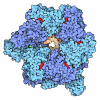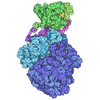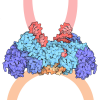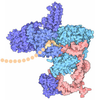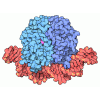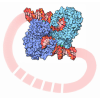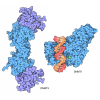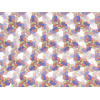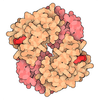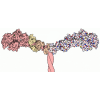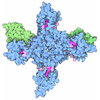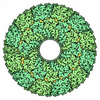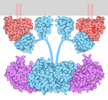+ Open data
Open data
- Basic information
Basic information
| Entry | Database: PDB / ID: 8x1c | ||||||
|---|---|---|---|---|---|---|---|
| Title | Structure of nucleosome-bound SRCAP-C in the ADP-bound state | ||||||
 Components Components |
| ||||||
 Keywords Keywords | DNA BINDING PROTEIN/DNA / Remodeler / SRCAP / H2A.Z / DNA BINDING PROTEIN-DNA complex | ||||||
| Function / homology |  Function and homology information Function and homology informationpositive regulation of lymphoid progenitor cell differentiation / histone H3K18ac reader activity / histone H3K27ac reader activity / promoter-enhancer loop anchoring activity / telomerase RNA localization to Cajal body / intestinal stem cell homeostasis / regulation of DNA strand elongation / hematopoietic stem cell homeostasis / positive regulation of telomere maintenance in response to DNA damage / positive regulation of norepinephrine uptake ...positive regulation of lymphoid progenitor cell differentiation / histone H3K18ac reader activity / histone H3K27ac reader activity / promoter-enhancer loop anchoring activity / telomerase RNA localization to Cajal body / intestinal stem cell homeostasis / regulation of DNA strand elongation / hematopoietic stem cell homeostasis / positive regulation of telomere maintenance in response to DNA damage / positive regulation of norepinephrine uptake / histone chaperone activity / establishment of protein localization to chromatin / R2TP complex / heart process / dynein axonemal particle / cellular response to cytochalasin B / bBAF complex / neural retina development / npBAF complex / nBAF complex / brahma complex / negative regulation of G0 to G1 transition / regulation of transepithelial transport / Swr1 complex / Formation of annular gap junctions / morphogenesis of a polarized epithelium / Formation of the dystrophin-glycoprotein complex (DGC) / structural constituent of postsynaptic actin cytoskeleton / RPAP3/R2TP/prefoldin-like complex / Gap junction degradation / GBAF complex / Folding of actin by CCT/TriC / protein localization to adherens junction / regulation of G0 to G1 transition / Cell-extracellular matrix interactions / Activation of the TFAP2 (AP-2) family of transcription factors / dense body / Tat protein binding / postsynaptic actin cytoskeleton / Ino80 complex / muscle cell differentiation / Prefoldin mediated transfer of substrate to CCT/TriC / blastocyst formation / RSC-type complex / regulation of double-strand break repair / nucleolus organization / regulation of nucleotide-excision repair / Adherens junctions interactions / RHOF GTPase cycle / adherens junction assembly / apical protein localization / positive regulation of DNA damage response, signal transduction by p53 class mediator / box C/D snoRNP assembly / protein folding chaperone complex / Sensory processing of sound by outer hair cells of the cochlea / Interaction between L1 and Ankyrins / tight junction / SWI/SNF complex / regulation of mitotic metaphase/anaphase transition / negative regulation of transcription by RNA polymerase I / Sensory processing of sound by inner hair cells of the cochlea / positive regulation of T cell differentiation / apical junction complex / positive regulation of double-strand break repair / spinal cord development / regulation of norepinephrine uptake / maintenance of blood-brain barrier / transporter regulator activity / regulation of chromosome organization / nitric-oxide synthase binding / cortical cytoskeleton / NuA4 histone acetyltransferase complex / RUNX1 interacts with co-factors whose precise effect on RUNX1 targets is not known / establishment or maintenance of cell polarity / positive regulation of stem cell population maintenance / positive regulation of transcription by RNA polymerase I / Regulation of MITF-M-dependent genes involved in pigmentation / Recycling pathway of L1 / TFIID-class transcription factor complex binding / regulation of DNA replication / regulation of T cell proliferation / brush border / regulation of G1/S transition of mitotic cell cycle / MLL1 complex / regulation of embryonic development / Telomere Extension By Telomerase / EPH-ephrin mediated repulsion of cells / somatic stem cell population maintenance / negative regulation of cell differentiation / kinesin binding / RHO GTPases Activate WASPs and WAVEs / regulation of synaptic vesicle endocytosis / positive regulation of transcription initiation by RNA polymerase II / positive regulation of myoblast differentiation / RHO GTPases activate IQGAPs / histone acetyltransferase activity / RNA polymerase II core promoter sequence-specific DNA binding / regulation of DNA repair / regulation of protein localization to plasma membrane / negative regulation of megakaryocyte differentiation Similarity search - Function | ||||||
| Biological species |  Homo sapiens (human) Homo sapiens (human)synthetic construct (others) | ||||||
| Method | ELECTRON MICROSCOPY / single particle reconstruction / cryo EM / Resolution: 3.2 Å | ||||||
 Authors Authors | Yu, J. / Wang, Q. / Yu, Z. / Li, W. / Wang, L. / Xu, Y. | ||||||
| Funding support |  China, 1items China, 1items
| ||||||
 Citation Citation |  Journal: Cell Discov / Year: 2024 Journal: Cell Discov / Year: 2024Title: Structural insights into histone exchange by human SRCAP complex. Authors: Jiali Yu / Fengrui Sui / Feng Gu / Wanjun Li / Zishuo Yu / Qianmin Wang / Shuang He / Li Wang / Yanhui Xu /  Abstract: Histone variant H2A.Z is found at promoters and regulates transcription. The ATP-dependent chromatin remodeler SRCAP complex (SRCAP-C) promotes the replacement of canonical histone H2A-H2B dimer with ...Histone variant H2A.Z is found at promoters and regulates transcription. The ATP-dependent chromatin remodeler SRCAP complex (SRCAP-C) promotes the replacement of canonical histone H2A-H2B dimer with H2A.Z-H2B dimer. Here, we determined structures of human SRCAP-C bound to H2A-containing nucleosome at near-atomic resolution. The SRCAP subunit integrates a 6-subunit actin-related protein (ARP) module and an ATPase-containing motor module. The ATPase-associated ARP module encircles half of the nucleosome along the DNA and may restrain net DNA translocation, a unique feature of SRCAP-C. The motor module adopts distinct nucleosome binding modes in the apo (nucleotide-free), ADP-bound, and ADP-BeF-bound states, suggesting that ATPase-driven movement destabilizes H2A-H2B by unwrapping the entry DNA and pulls H2A-H2B out of nucleosome through the ZNHIT1 subunit. Structure-guided chromatin immunoprecipitation sequencing analysis confirmed the requirement of H2A-contacting ZNHIT1 in maintaining H2A.Z occupancy on the genome. Our study provides structural insights into the mechanism of H2A-H2A.Z exchange mediated by SRCAP-C. | ||||||
| History |
|
- Structure visualization
Structure visualization
| Structure viewer | Molecule:  Molmil Molmil Jmol/JSmol Jmol/JSmol |
|---|
- Downloads & links
Downloads & links
- Download
Download
| PDBx/mmCIF format |  8x1c.cif.gz 8x1c.cif.gz | 1.3 MB | Display |  PDBx/mmCIF format PDBx/mmCIF format |
|---|---|---|---|---|
| PDB format |  pdb8x1c.ent.gz pdb8x1c.ent.gz | Display |  PDB format PDB format | |
| PDBx/mmJSON format |  8x1c.json.gz 8x1c.json.gz | Tree view |  PDBx/mmJSON format PDBx/mmJSON format | |
| Others |  Other downloads Other downloads |
-Validation report
| Summary document |  8x1c_validation.pdf.gz 8x1c_validation.pdf.gz | 1.1 MB | Display |  wwPDB validaton report wwPDB validaton report |
|---|---|---|---|---|
| Full document |  8x1c_full_validation.pdf.gz 8x1c_full_validation.pdf.gz | 1.2 MB | Display | |
| Data in XML |  8x1c_validation.xml.gz 8x1c_validation.xml.gz | 135 KB | Display | |
| Data in CIF |  8x1c_validation.cif.gz 8x1c_validation.cif.gz | 198 KB | Display | |
| Arichive directory |  https://data.pdbj.org/pub/pdb/validation_reports/x1/8x1c https://data.pdbj.org/pub/pdb/validation_reports/x1/8x1c ftp://data.pdbj.org/pub/pdb/validation_reports/x1/8x1c ftp://data.pdbj.org/pub/pdb/validation_reports/x1/8x1c | HTTPS FTP |
-Related structure data
| Related structure data |  37990MC  8x15C  8x19C M: map data used to model this data C: citing same article ( |
|---|---|
| Similar structure data | Similarity search - Function & homology  F&H Search F&H Search |
- Links
Links
- Assembly
Assembly
| Deposited unit | 
|
|---|---|
| 1 |
|
- Components
Components
-Protein , 14 types, 23 molecules AEBFCGDHIJKLMOQNPRSUTVW
| #1: Protein | Mass: 14135.523 Da / Num. of mol.: 2 Source method: isolated from a genetically manipulated source Source: (gene. exp.)  Homo sapiens (human) / Gene: H2AC6, H2AFL, HIST1H2AC / Production host: Homo sapiens (human) / Gene: H2AC6, H2AFL, HIST1H2AC / Production host:  #2: Protein | Mass: 13937.213 Da / Num. of mol.: 2 Source method: isolated from a genetically manipulated source Source: (gene. exp.)  Homo sapiens (human) Homo sapiens (human)Gene: H2BC4, H2BFL, HIST1H2BC, H2BC6, H2BFH, HIST1H2BE, H2BC7, H2BFG, HIST1H2BF, H2BC8, H2BFA, HIST1H2BG, H2BC10, H2BFK, HIST1H2BI Production host:  #3: Protein | Mass: 15437.167 Da / Num. of mol.: 2 Source method: isolated from a genetically manipulated source Source: (gene. exp.)  Homo sapiens (human) Homo sapiens (human)Gene: H3C1, H3FA, HIST1H3A, H3C2, H3FL, HIST1H3B, H3C3, H3FC HIST1H3C, H3C4, H3FB, HIST1H3D, H3C6, H3FD, HIST1H3E, H3C7, H3FI, HIST1H3F, H3C8, H3FH, HIST1H3G, H3C10, H3FK, HIST1H3H, H3C11, H3FF, ...Gene: H3C1, H3FA, HIST1H3A, H3C2, H3FL, HIST1H3B, H3C3, H3FC HIST1H3C, H3C4, H3FB, HIST1H3D, H3C6, H3FD, HIST1H3E, H3C7, H3FI, HIST1H3F, H3C8, H3FH, HIST1H3G, H3C10, H3FK, HIST1H3H, H3C11, H3FF, HIST1H3I, H3C12, H3FJ, HIST1H3J Production host:  #4: Protein | Mass: 11394.426 Da / Num. of mol.: 2 Source method: isolated from a genetically manipulated source Source: (gene. exp.)  Homo sapiens (human) Homo sapiens (human)Gene: H4C1, H4/A, H4FA, HIST1H4A, H4C2, H4/I, H4FI, HIST1H4B, H4C3, H4/G, H4FG, HIST1H4C, H4C4, H4/B, H4FB, HIST1H4D, H4C5, H4/J, H4FJ, HIST1H4E, H4C6, H4/C, H4FC, HIST1H4F, H4C8, H4/H, H4FH, ...Gene: H4C1, H4/A, H4FA, HIST1H4A, H4C2, H4/I, H4FI, HIST1H4B, H4C3, H4/G, H4FG, HIST1H4C, H4C4, H4/B, H4FB, HIST1H4D, H4C5, H4/J, H4FJ, HIST1H4E, H4C6, H4/C, H4FC, HIST1H4F, H4C8, H4/H, H4FH, HIST1H4H, H4C9, H4/M, H4FM, HIST1H4I, H4C11, H4/E, H4FE, HIST1H4J, H4C12, H4/D, H4FD, HIST1H4K, H4C13, H4/K, H4FK, HIST1H4L, H4C14, H4/N, H4F2, H4FN, HIST2H4, HIST2H4A, H4C15, H4/O, H4FO, HIST2H4B, H4C16, H4-16, HIST4H4 Production host:  #5: Protein | | Mass: 343915.250 Da / Num. of mol.: 1 Source method: isolated from a genetically manipulated source Source: (gene. exp.)  Homo sapiens (human) / Gene: SRCAP, KIAA0309 / Production host: Homo sapiens (human) / Gene: SRCAP, KIAA0309 / Production host:  Homo sapiens (human) Homo sapiens (human)References: UniProt: Q6ZRS2, Hydrolases; Acting on acid anhydrides; Acting on acid anhydrides to facilitate cellular and subcellular movement #6: Protein | | Mass: 40658.363 Da / Num. of mol.: 1 Source method: isolated from a genetically manipulated source Source: (gene. exp.)  Homo sapiens (human) / Gene: VPS72, TCFL1, YL1 / Production host: Homo sapiens (human) / Gene: VPS72, TCFL1, YL1 / Production host:  Homo sapiens (human) / References: UniProt: Q15906 Homo sapiens (human) / References: UniProt: Q15906#7: Protein | | Mass: 45857.902 Da / Num. of mol.: 1 Source method: isolated from a genetically manipulated source Source: (gene. exp.)  Homo sapiens (human) / Gene: ACTR6, CDA12 / Production host: Homo sapiens (human) / Gene: ACTR6, CDA12 / Production host:  Homo sapiens (human) / References: UniProt: Q9GZN1 Homo sapiens (human) / References: UniProt: Q9GZN1#8: Protein | | Mass: 17567.023 Da / Num. of mol.: 1 Source method: isolated from a genetically manipulated source Source: (gene. exp.)  Homo sapiens (human) / Gene: ZNHIT1, CGBP1, ZNFN4A1 / Production host: Homo sapiens (human) / Gene: ZNHIT1, CGBP1, ZNFN4A1 / Production host:  Homo sapiens (human) / References: UniProt: O43257 Homo sapiens (human) / References: UniProt: O43257#9: Protein | Mass: 50296.914 Da / Num. of mol.: 3 Source method: isolated from a genetically manipulated source Source: (gene. exp.)  Homo sapiens (human) / Gene: RUVBL1, INO80H, NMP238, TIP49, TIP49A / Production host: Homo sapiens (human) / Gene: RUVBL1, INO80H, NMP238, TIP49, TIP49A / Production host:  Homo sapiens (human) / References: UniProt: Q9Y265, DNA helicase Homo sapiens (human) / References: UniProt: Q9Y265, DNA helicase#10: Protein | Mass: 51222.465 Da / Num. of mol.: 3 Source method: isolated from a genetically manipulated source Source: (gene. exp.)  Homo sapiens (human) / Gene: RUVBL2, INO80J, TIP48, TIP49B, CGI-46 / Production host: Homo sapiens (human) / Gene: RUVBL2, INO80J, TIP48, TIP49B, CGI-46 / Production host:  Homo sapiens (human) / References: UniProt: Q9Y230, DNA helicase Homo sapiens (human) / References: UniProt: Q9Y230, DNA helicase#11: Protein | Mass: 41782.660 Da / Num. of mol.: 2 Source method: isolated from a genetically manipulated source Source: (gene. exp.)  Homo sapiens (human) / Gene: ACTB / Production host: Homo sapiens (human) / Gene: ACTB / Production host:  Homo sapiens (human) Homo sapiens (human)References: UniProt: P60709, Hydrolases; Acting on acid anhydrides; Acting on acid anhydrides to facilitate cellular and subcellular movement #12: Protein | | Mass: 47509.812 Da / Num. of mol.: 1 Source method: isolated from a genetically manipulated source Source: (gene. exp.)  Homo sapiens (human) / Gene: ACTL6A, BAF53, BAF53A, INO80K / Production host: Homo sapiens (human) / Gene: ACTL6A, BAF53, BAF53A, INO80K / Production host:  Homo sapiens (human) / References: UniProt: O96019 Homo sapiens (human) / References: UniProt: O96019#13: Protein | | Mass: 53090.699 Da / Num. of mol.: 1 Source method: isolated from a genetically manipulated source Source: (gene. exp.)  Homo sapiens (human) / Gene: DMAP1, KIAA1425 / Production host: Homo sapiens (human) / Gene: DMAP1, KIAA1425 / Production host:  Homo sapiens (human) / References: UniProt: Q9NPF5 Homo sapiens (human) / References: UniProt: Q9NPF5#14: Protein | | Mass: 26541.537 Da / Num. of mol.: 1 Source method: isolated from a genetically manipulated source Source: (gene. exp.)  Homo sapiens (human) / Gene: YEATS4, GAS41 / Production host: Homo sapiens (human) / Gene: YEATS4, GAS41 / Production host:  Homo sapiens (human) / References: UniProt: O95619 Homo sapiens (human) / References: UniProt: O95619 |
|---|
-DNA chain , 2 types, 2 molecules XY
| #15: DNA chain | Mass: 45644.070 Da / Num. of mol.: 1 / Source method: obtained synthetically / Source: (synth.) synthetic construct (others) |
|---|---|
| #16: DNA chain | Mass: 45105.727 Da / Num. of mol.: 1 / Source method: obtained synthetically / Source: (synth.) synthetic construct (others) |
-Non-polymers , 2 types, 10 molecules 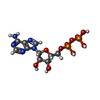
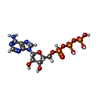

| #17: Chemical | ChemComp-ADP / #18: Chemical | |
|---|
-Details
| Has ligand of interest | Y |
|---|
-Experimental details
-Experiment
| Experiment | Method: ELECTRON MICROSCOPY |
|---|---|
| EM experiment | Aggregation state: PARTICLE / 3D reconstruction method: single particle reconstruction |
- Sample preparation
Sample preparation
| Component | Name: Structure of nucleosome-bound SRCAP-C in the ADP-bound state Type: COMPLEX / Entity ID: #1-#16 / Source: MULTIPLE SOURCES |
|---|---|
| Source (natural) | Organism:  Homo sapiens (human) Homo sapiens (human) |
| Source (recombinant) | Organism:  Homo sapiens (human) Homo sapiens (human) |
| Buffer solution | pH: 8 |
| Specimen | Embedding applied: NO / Shadowing applied: NO / Staining applied: NO / Vitrification applied: YES |
| Vitrification | Cryogen name: ETHANE |
- Electron microscopy imaging
Electron microscopy imaging
| Experimental equipment |  Model: Titan Krios / Image courtesy: FEI Company |
|---|---|
| Microscopy | Model: FEI TITAN KRIOS |
| Electron gun | Electron source:  FIELD EMISSION GUN / Accelerating voltage: 300 kV / Illumination mode: FLOOD BEAM FIELD EMISSION GUN / Accelerating voltage: 300 kV / Illumination mode: FLOOD BEAM |
| Electron lens | Mode: BRIGHT FIELD / Nominal defocus max: 2500 nm / Nominal defocus min: 1500 nm |
| Image recording | Electron dose: 50 e/Å2 / Film or detector model: GATAN K3 (6k x 4k) |
- Processing
Processing
| CTF correction | Type: PHASE FLIPPING AND AMPLITUDE CORRECTION |
|---|---|
| 3D reconstruction | Resolution: 3.2 Å / Resolution method: FSC 0.143 CUT-OFF / Num. of particles: 555303 / Symmetry type: POINT |
 Movie
Movie Controller
Controller





 PDBj
PDBj
